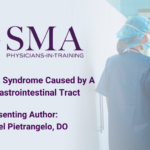Abstract | May 7, 2021
Broken Heart Syndrome Caused by A Broken Gastrointestinal Tract
Learning Objectives
- Upon completion of this lecture, learners should be better prepared to identify septic shock as a cause of cardiogenic shock secondary to Takotsubo cardiomyopathy.
Introduction:
Takotsubo cardiomyopathy (TC) is a nonischemic cardiomyopathy that develops when there is a massive catecholamine release after a stressful event. In this case, the patient developed TC after a salmonella bloodstream infection (BSI) caused septic and cardiogenic shock requiring an intra-aortic balloon pump (IABP). Salmonella enterica is rarely reported to cause endovascular BSI. Ultimately after antibiotics, vasopressor support, and IV fluids, the patient was discharged.
Case Report:
A 70-year-old female with diabetes, hypertension, and prior stroke presented with fever of 106° F and sepsis secondary to salmonella enterica BSI with right sided colitis on CT scan, but enteric pathogen stool panel was negative. Initial laboratory results significant for WBC 5.0 K/uL, 49% bandemia, and lactic acid of 2.1 mmol/L. IV fluid resuscitation and vancomycin, meropenem, and metronidazole were initiated for broad coverage. Echocardiogram showed severe anterior, anteroapical, anterolateral, apical and inferoapical hypokinesis with ejection fraction (EF) of 20% concerning for TC. Patient decompensated requiring 15 L on non rebreather, chest pain, and requiring vasopressor support with cold, clammy extremities. Laboratory results at this time showed troponin I of 4.38 ng/mL, lactic acid of 4.2 mmol/L, and 82% bandemia. Cardiology and infectious disease were consulted and an emergent left heart catheterization required 3 drug eluting stents to the left anterior descending artery and an IABP placed. Patient remained in the ICU on a dobutamine infusion and cefepime.
Final/Working Diagnosis:
This case highlights two branchpoints in diagnosis: ischemic versus Takotsubo cardiomyopathy and gastrointestinal versus endovascular source of BSI. After blood culture grew salmonella species, CT scan showed right sided colitis, and echocardiogram showed concern for TC, the working diagnosis was TC induced by salmonella enteritis. After ischemic evaluation revealed occlusion of LAD and enteric pathogen stool panel was negative, the concern was that it was TC triggered by a non-ST segment elevation myocardial infarction (NSTEMI) due to significant vascular disease.
Management/Outcome/Follow-Up:
Ultimately, the patient was discharged from the hospital to a skilled nursing facility with IV antibiotic therapy, wearable cardioverter defibrillator, and had a repeat echocardiogram showing EF of 55% with septal hypokinesis. Despite IV cefepime, patient developed T2-3 diskitis requiring addition of IV daptomycin.

